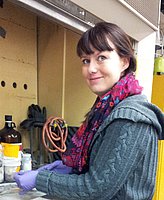My research stay at Purdue University, IN, USA
In Spring 2015, the RESOLV Graduate School Solvation Science gave me the opportunity for a two month research stay in the laboratory of Prof. Zwier at Purdue University in Indiana, USA, to advance my PhD project. I reached Indiana at the end of February, and while in Bochum the spring was already arriving, the winter still clung to the midwest with snow and freezing cold. Luckily, all my new colleagues and staff at the university were the total opposite of the weather and gave me a warm welcome. During my stay, they supported and helped me a lot and I really had the feeling of being a part of the group and the university.
My research project was the investigation of two small biomolecules (cyclic tetrapeptides mimicking ß-turns) that had been synthesized in Bochum by another GSS PhD student. Two small samples of these fine white powders were shipped from Bochum to the US in the middle of February but were held up in Customs at the Detroit airport. So my first task was to get my samples released, which took almost three additional weeks and numerous calls by my US lab colleague. With six weeks left before returning I finally began my investigation.
Science Zone
My experiment consist in bringing the small molecules into a vacuum chamber by ablating them from a graphite rod with a laser beam and then measuring the wavelengths at which they absorb the light of a second laser beam. By comparing the absorption spectrum with calculated spectra we can deduce the three dimensional structure – the conformation – of the molecule, which aides in determining the function of biomolecules. The main reason for my stay at Purdue University was that they have lasers there that produce light in another wavelength regime than the ones we have in our lab. With the information from the additional wavelength regions we can determine the conformation more unambiguously. Apart from the laser source, the apparatus at Purdue looks quite similar to our instrument in Bochum and a lot of the components are the same. Therefore, I quickly felt familiar with the set-up.
The two small towns where Purdue is located are Lafayette and West Lafayette and they are in the middle of nowhere in Indiana. Their advertisement claim is “Two great cities, one great university,” which is, as I think, way better than Bochum’s “UniverCity.” Unfortunately, this is the only thing that the home of Purdue is ahead of Bochum: there is not much to do and to experience in Lafayette/West Lafayette except the university. The weekend highlights were taking part in a 5k charity run with the whole group and doing trips to Indianapolis and Chicago with two really nice colleagues. With my accommodation I also had some luck: a student from Prof. Zwier’s lab came to Bochum in my place, which meant we could interchange our flats and office places. My new place was located directly off Lafayette’s Main Street, in a nice old building with high ceilings and decorated affectionately with all kinds of American sports memorabilia. The good things about living in a quieter area are that even on Main Street nothing can disturb your sleep on a Friday night and not much can distract you from research.
I had no time after the three-week delay in obtaining my samples, especially because the project was more demanding than I had thought and I had to try all kinds of conditions to get good absorption spectra. In the end, I worked until the last possible minute and I wished I could have stayed just one more week. But it was time to go home and I really almost made it to measure in all the wavelength regions as planned in the beginning. Of course I was happy to see my family and friends here in Bochum and to return to Bochum itself, but I have to say that I really enjoyed working in the Zwier lab. The atmosphere was great, Prof. Zwier was always considerate and his team a great help. It was a wonderful experience, I would do it again and I can recommend it to everyone who has the chance.
————————————————————————————————————————————
About the author



